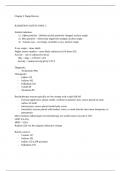Class notes
Laura Nappi Comprehensive Review Guide Chapter 2 Notes
- Course
- RADT
- Institution
- Wallace State Community College Hanceville
Very thorough notes on Chapter 2 of the Lauri Nappi Review Guide. These notes will prepare you for a test on this chapter and help you study for your ARRT board exam.
[Show more]



